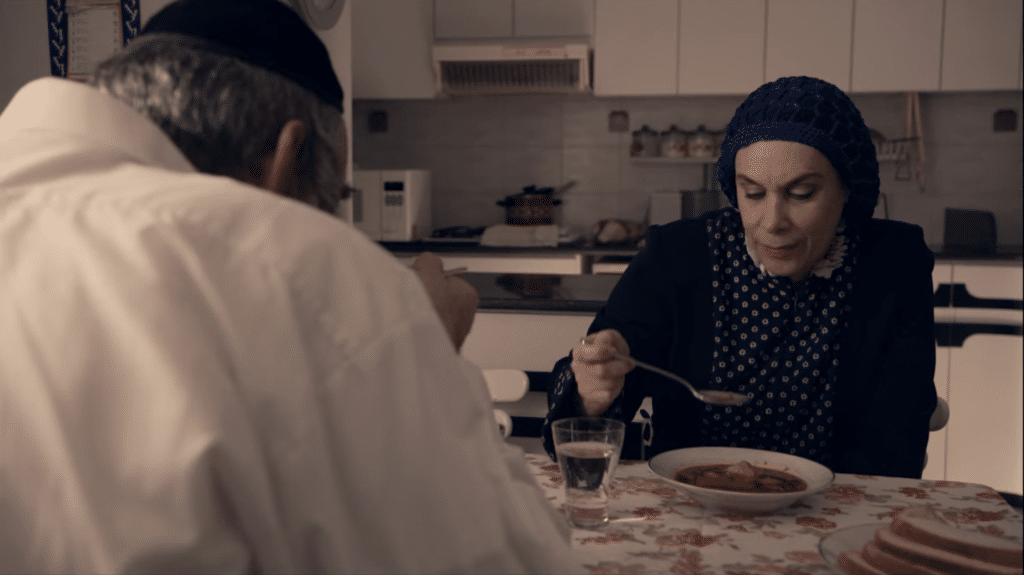
As often is the case in Jewish tradition, food is at the center of all things. It can heal broken hearts, bring people together, and warm even the coldest of days. Any fan of Shtisel will know that not an episode passes without our beloved Shtisel family making, sharing, and noshing on traditional Ashkenazi and Israeli dishes. Here’s how to make 3 of them!
Israeli breakfast… lunch and dinner
In Israel, the most common way to start your day is with some variation of an omelette, salads, and spreads. When Israeli’s simply say “salad,” you know they’re referring to that fresh chopped cucumber and tomato mix. In Shtisel, it is often this meal that decorates the family’s table. Here’s how to make this simply, yet perfectly delicious salad:

Israeli Salad by Tori Avey
Ingredients
- 1 lb Persian cucumbers, diced
- 1 lb fresh ripe tomatoes, seeded and diced
- 1/3 cup minced onion (optional)
- 1/2 cup minced fresh parsley
- 3 tbsp extra virgin olive oil
- 3 tbsp fresh lemon juice
- Salt to taste (I use about 1/2 tsp)
Directions
- Slice the Persian cucumber in half lengthwise.
- Slice each half into 4 slices lengthwise, so you have 8 long, thin pieces total.
- Hold the long, thin pieces together with one hand, and slice the bunch into very small pieces with the other hand. Note: Persian cucumbers have lots of little seeds, which add to their flavor. If you have trouble digesting seeds, you can seed the cucumber easily by slicing it in half lengthwise and scooping out the seed-filled center.
- Place the diced cucumbers into a large mixing bowl along with all the other ingredients.
- Mix until vegetables are well coated with parsley, oil, lemon juice, and salt.
- Best served fresh at room temperature. You can also serve chilled for a more refreshing salad.
Kugel
Kugel is one of those Ashkenazi Jewish foods that — like gefilte fish — you either love or hate. It’s basically a sweet noodle casserole, often served with sour cream, applesauce and fresh strawberries. It’s often eaten on Shabbat or holidays; But in Shtisel’s first season, Akiva has a dream that his mom misses the kugel at their local go-to restaurant: Anshin’s. So here’s an easy recipe to try the dish that Dvorah Shtisel was supposedly craving:

Noodle Kugel by Dave Lieberman
Ingredients
- 1/2 pound wide egg noodles
- 1/2 stick butter, melted
- 1 pound cottage cheese
- 2 cups sour cream
- 1/2 cup sugar
- 6 eggs
- 1 teaspoon ground cinnamon
- 1/2 cup raisins
Directions
- Preheat oven to 375 degrees F.
- Boil the noodles in salted water for about 4 minutes. Strain noodles from water. In a large mixing bowl, combine noodles with remaining ingredients and pour into a greased, approximately 9-by-13-inch baking dish.
- Bake until custard is set and top is golden brown, about 30 to 45 minutes.
Cholent
Shulem Shtisel and his assistant, Aliza Gvili, have a complicated relationship — largely centred around Aliza’s culinary skills. She’s constantly making Shulem different meals and soups. One of her go-to’s is Cholent: a traditional Ashkenazi Jewish stew made with beef, potatoes, beans and eggs. It’s often simmered overnight for 12 hours or more, and eaten for lunch on Shabbat.

Cholent by Tori Avey
Ingredients
- 2 1/2 lbs large red potatoes, peeled and halved (for a smaller slow cooker, use 2 lbs)
- 2 whole onions, chopped
- 2 1/2 lbs beef stew meat or brisket, cut into chunks (for a smaller slow cooker, use 2 lbs)
- 2 marrow bones
- 1 cup dried beans – lima, pinto, chickpeas, red beans (not kidney), or a mixture
- 1/2 cup pearl barley or coarse-grain kasha (optional – for gluten free, do not use pearl barley)
- 3 whole garlic cloves
- 6 eggs (optional)
- 1/2 tsp black pepper (if spice sensitive use 1/4 tsp)
- 1 quart low sodium chicken broth
- 1 tbsp kosher salt
- 1 1/2 tsp paprika
- 1 1/2 tsp turmeric
- 1 tsp cumin
- 1/4 tsp cayenne (if spice sensitive use just a pinch)
- 1 kishke (optional – we never add this, but many families like it)
- Water (varies)
Directions
- In a large slow cooker (the larger the better!), place the potatoes in a single layer on the bottom of the cooking vessel.
- Sprinkle the onions over the potatoes.
- Place the beef in a single layer on top of the onions and potatoes. Place the two marrow bones in the meat. If you’re adding a kishke, now would be the time to put it in the cooker.
- Rinse the beans clean, checking for any stones or impurities. If using barley or kasha, do the same with the grains. Sprinkle the beans (raw or pre-soaked) and optional grains over the top of the meat. Place the three whole garlic cloves into the meat, evenly spaced. Sprinkle the whole mixture with the black pepper.
- If using eggs, rinse them well and then tuck them into the meat. In a 4-cup container, whisk together the low sodium chicken broth, kosher salt, paprika, turmeric, cumin and cayenne.
- Pour the liquid over the cholent. Add additional water until all of the beans and pieces of meat are covered. For us, it’s usually another 1-2 cups of water in our slow cooker– it will vary; I usually add a bit more liquid if using grains, because they will soak it up.
- Cover the slow cooker. Cook on low heat for 16 hours. Check occasionally as it’s cooking; add additional water and stir a bit if it’s looking too dry. Most cookers will auto-switch to warm when the cooking is complete. If yours doesn’t, set it to warm until ready to serve.
- It will look a bit medieval when it’s done cooking! Don’t worry, just dig in and you’ll see that it’s perfectly cooked below the surface. Peel the eggs before serving the cholent.
- To cook this recipe in the oven, layer the ingredients in a large heavy 7-8 quart Dutch oven. Make sure you have enough liquid to just cover all ingredients. Cover with lid and cook cholent at 200 degrees F for 12-16 hours.
